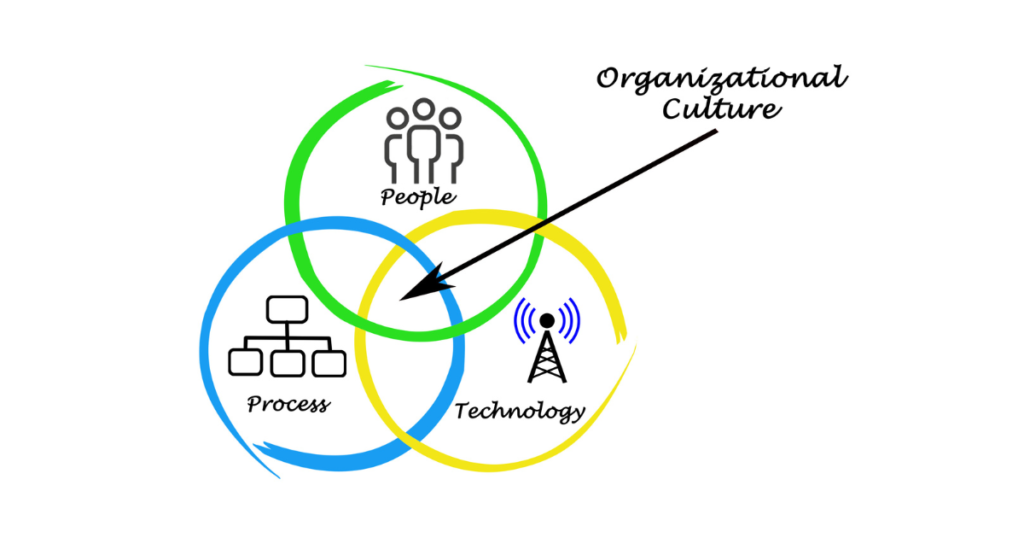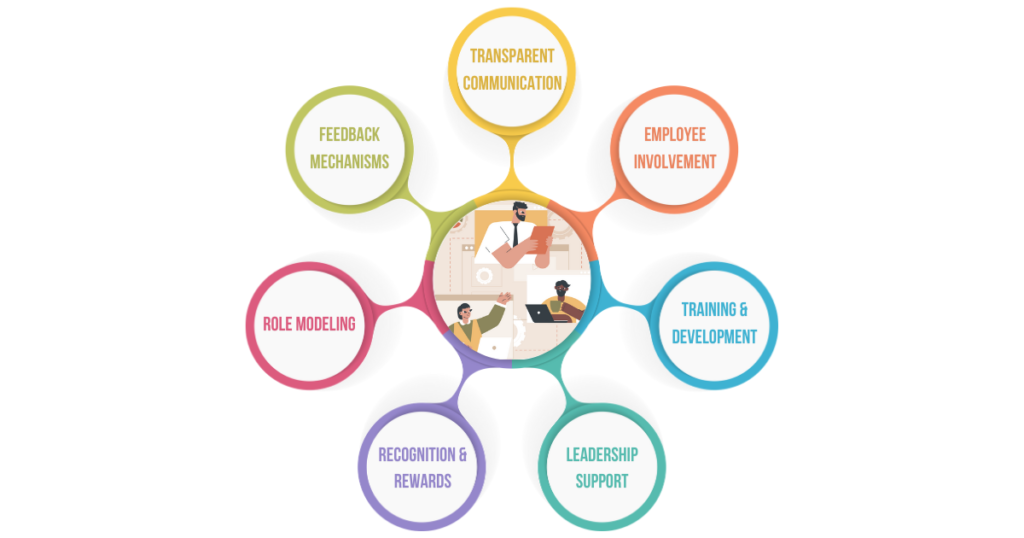Table of Contents
Organizational culture is the lifeblood of any company, shaping its identity, guiding its actions, and ultimately determining its success. Yet, as businesses evolve and adapt to new challenges, the need for cultural transformation often arises. In this comprehensive guide, we delve into the intricacies of organizational culture change, providing insights, strategies, and real-world examples to help you navigate this complex terrain.
Culture change is not merely a desirable aspiration; it’s a strategic imperative in today’s dynamic business landscape. Whether prompted by shifts in leadership, market disruptions, or internal challenges, mastering the art of culture change is essential for organizational resilience and longevity.
Through this guide, we aim to demystify the process of cultural transformation, offering practical advice and actionable steps to empower leaders, HR professionals, and change agents alike. From understanding the fundamentals of culture change to implementing effective strategies and leveraging technology, we cover all aspects of this journey.
Join us as we explore the importance of organizational culture change and embark on a transformative journey to unlock the full potential of your organization. Whether you’re facing resistance from employees or grappling with the complexities of change management, this guide equips you with the knowledge and tools to navigate the path ahead with confidence.
Get ready to embark on a journey of discovery, innovation, and growth as we unravel the secrets to mastering organizational culture change.
Understanding Organizational Culture Change

Organizational culture change is a complex and multifaceted process that requires a deep understanding of the underlying dynamics at play within an organization. To embark on a successful cultural transformation journey, it’s essential to grasp the nuances of why and how cultures evolve and the impact they have on organizational performance and employee engagement.
Cultural Dynamics and Evolution: Organizational culture is deeply ingrained in the beliefs, values, norms, and behaviours that define how work is conducted within a company. It evolves over time in response to internal and external factors, including changes in leadership, market dynamics, and industry trends. Understanding the underlying cultural dynamics and how they shape employee attitudes and behaviours is crucial for driving meaningful culture change initiatives.
Impact on Organizational Performance: Culture plays a significant role in shaping organizational performance, influencing everything from employee productivity and innovation to customer satisfaction and business outcomes. A positive and adaptive culture fosters collaboration, creativity, and agility, enabling organizations to navigate change more effectively and stay ahead of the competition. Conversely, a toxic or stagnant culture can hinder innovation, stifle employee engagement, and impede organizational growth.
Employee Engagement and Buy-In: Central to any successful culture change effort is garnering employee buy-in and engagement. Employees are not only the beneficiaries of cultural change but also key drivers of its success. Engaging employees early in the process, soliciting their input, and involving them in decision-making can foster a sense of ownership and commitment to the change initiative. Moreover, creating a safe and inclusive environment where employees feel valued, heard, and empowered to contribute can enhance morale and motivation, driving momentum for cultural transformation.
Enrol in the Organizational Culture Change course and learn how to deploy changes with an IRL case study successfully.
Understanding the dynamics of organizational culture change, its impact on performance, and the critical role of employee engagement is foundational to embarking on a successful culture change journey. In the following sections, we will delve into human-centric approaches to culture change, overcoming traditional challenges, and leveraging technology to drive effective change management strategies.
The Human-Centric Approach to Organizational Cultural Change

Embracing a human-centric approach to culture change recognizes that organizational transformation is fundamentally about people. Rather than viewing employees as passive recipients of change, this approach emphasizes collaboration, empathy, and inclusivity, placing individuals at the heart of the change process. Here’s how organizations can adopt a human-centric approach to drive cultural change effectively:
1. Co-Creation and Collaboration: Encourage active participation from employees at all levels of the organization by fostering a culture of co-creation and collaboration. By involving employees in the change process from the outset, organizations can harness diverse perspectives, tap into collective intelligence, and co-create solutions that resonate with the workforce. This not only enhances the quality of change initiatives but also fosters a sense of ownership and commitment among employees.
2. Empathy and Psychological Safety: Create a psychologically safe environment where employees feel comfortable expressing their thoughts, concerns, and ideas without fear of judgment or reprisal. Cultivating empathy among leaders and colleagues fosters trust, openness, and mutual respect, laying the foundation for meaningful dialogue and collaboration. By demonstrating empathy and actively listening to employee feedback, organizations can build stronger relationships, foster a culture of psychological safety, and drive positive cultural change.
3. Values Alignment and Purpose-Driven Leadership: Align organizational values with individual values and emphasize a shared sense of purpose to inspire and motivate employees toward a common goal. Purpose-driven leadership that articulates a compelling vision and reinforces core values helps employees connect their work to a higher purpose, driving engagement, and commitment to cultural change. By embedding values alignment and purpose-driven leadership into organizational practices and decision-making processes, organizations can cultivate a culture that reflects their desired identity and aspirations.
4. Continuous Learning and Growth: Promote a culture of continuous learning, experimentation, and growth to adapt to changing circumstances and foster innovation. Encourage employees to embrace a growth mindset, embrace failure as a learning opportunity, and seek feedback to drive personal and professional development. By providing opportunities for skill development, knowledge sharing, and cross-functional collaboration, organizations can empower employees to thrive in an ever-evolving environment and drive cultural change from within.
Adopting a human-centric approach to culture change prioritizes the well-being, engagement, and empowerment of employees, recognizing them as active participants and co-creators of change. By fostering collaboration, empathy, values alignment, and a culture of continuous learning, organizations can drive meaningful cultural transformation that enhances employee satisfaction, performance, and organizational success.
Overcoming Traditional Challenges with Co-Creation

Co-creation stands as a powerful antidote to the traditional top-down approach to change management, offering a more inclusive and effective strategy for overcoming common challenges in cultural transformation. By engaging employees as active participants and leveraging their collective intelligence, organizations can address key obstacles to change and drive successful cultural evolution. Here’s how co-creation helps overcome traditional challenges:
Resistance to Change: Traditional change initiatives often face resistance from employees who feel disempowered or disconnected from the change process. Co-creation empowers employees by inviting them to contribute their insights, ideas, and expertise, fostering a sense of ownership and investment in the change effort. By involving employees in shaping the direction and implementation of change, organizations can mitigate resistance and build buy-in from the ground up.
Lack of Engagement and Buy-In: In the absence of meaningful involvement, employees may feel disengaged or sceptical about the need for change, undermining the success of cultural transformation initiatives. Co-creation cultivates a culture of engagement and buy-in by valuing employees’ perspectives, soliciting their input, and involving them in decision-making processes. By fostering a sense of ownership and shared responsibility for change, organizations can garner support and commitment from employees at all levels.
Limited Innovation and Creativity: Top-down approaches to change management often stifle innovation and creativity, relying on predetermined solutions rather than tapping into the diverse talents and perspectives of employees. Co-creation unlocks the creative potential of the workforce by harnessing collective intelligence, encouraging experimentation, and exploring new ideas collaboratively. By fostering a culture of innovation and continuous improvement, organizations can drive transformative change that adapts to evolving challenges and opportunities.
Siloed Thinking and Communication: Silos within organizations can impede effective communication, collaboration, and alignment, hindering the success of cultural change initiatives. Co-creation breaks down silos by promoting cross-functional collaboration, facilitating open dialogue, and fostering a culture of transparency and inclusivity. By bridging departmental boundaries and encouraging interdisciplinary teamwork, organizations can overcome siloed thinking and create a shared understanding of change objectives and priorities.
Co-creation offers a powerful alternative to traditional change management approaches, enabling organizations to overcome resistance, foster engagement, stimulate innovation, and break down silos. By embracing co-creation as a guiding principle in cultural transformation efforts, organizations can leverage the collective wisdom and creativity of their workforce to drive meaningful and sustainable change.
Leveraging Technology for Effective Change Management

In today’s digital age, technology plays a crucial role in facilitating effective change management, particularly in the realm of cultural transformation. By leveraging innovative tools and platforms, organizations can streamline communication, collaboration, and engagement, enhancing the success of their change initiatives. Here’s how technology can be harnessed to drive effective change management:
Communication and Collaboration Platforms: Technology provides organizations with a wide range of communication and collaboration platforms, such as Slack, Microsoft Teams, and Zoom, that enable real-time interaction and information sharing among employees. These platforms facilitate open dialogue, foster transparency, and break down geographical barriers, allowing dispersed teams to collaborate effectively on change initiatives. By providing a centralized hub for communication and collaboration, technology enhances engagement and alignment across the organization.
Change Management Software: Dedicated change management software platforms, such as Prosci’s Change Management Toolkit or Howspace, offer comprehensive tools and resources for planning, executing, and monitoring change initiatives. These platforms enable organizations to develop detailed change plans, track progress, and gather feedback from stakeholders in a structured and systematic manner. By providing visibility into the change process and facilitating data-driven decision-making, change management software enhances the effectiveness and efficiency of change management efforts.
Employee Feedback and Engagement Tools: Technology-enabled feedback and engagement tools, such as survey platforms like SurveyMonkey or employee engagement platforms like Glint or OfficeVibe, allow organizations to solicit feedback from employees, measure engagement levels, and identify areas for improvement. These tools enable organizations to gather insights, address concerns, and foster a culture of continuous feedback and improvement. By actively involving employees in the change process and addressing their needs and concerns, organizations can enhance engagement and buy-in for change initiatives.
Learning and Development Platforms: Technology-driven learning and development platforms, such as Udemy, Coursera, or LinkedIn Learning, and also Leading Business Improvement (LBI) by Robert Chapman offer a wide range of online courses, training modules, and resources to support employee skill development and learning. These platforms enable organizations to provide targeted training and development opportunities to employees, equipping them with the knowledge and skills needed to adapt to change effectively. By investing in employee learning and development, organizations can enhance readiness for change and build a culture of continuous learning and growth.
Data Analytics and Insights: Advanced data analytics tools and platforms enable organizations to collect, analyze, and derive insights from data related to change management efforts. These tools allow organizations to track key performance indicators, identify trends, and measure the impact of change initiatives on business outcomes. By leveraging data-driven insights, organizations can make informed decisions, optimize change strategies, and drive continuous improvement in change management practices.
Technology offers organizations a wide range of tools and platforms to support effective change management, from communication and collaboration platforms to dedicated change management software, employee feedback and engagement tools, learning and development platforms, and data analytics tools. By leveraging technology strategically, organizations can enhance communication, collaboration, engagement, learning, and decision-making, driving successful cultural transformation and organizational change.
Real-world examples of Successful Culture Shifts

While understanding the principles and strategies behind cultural change is crucial, seeing real-world examples in action can provide valuable insights and inspiration for organizations embarking on their own change journeys. Here are some notable examples of organizations that have successfully navigated cultural shifts:
1. Google: Embracing Innovation and Collaboration: Google is renowned for its innovative and collaborative culture, which fosters creativity, experimentation, and risk-taking. Through initiatives like “20% time,” where employees are encouraged to spend a portion of their workweek on passion projects, Google empowers its employees to pursue their interests and explore new ideas. This culture of innovation has enabled Google to develop groundbreaking products and services, from Gmail to Google Maps, and maintain its position as a leader in the technology industry.
2. Netflix: Embracing Flexibility and Freedom: Netflix has embraced a culture of flexibility and freedom, trusting employees to manage their own time and make decisions autonomously. With policies like unlimited vacation and no formal expense policies, Netflix empowers its employees to take ownership of their work and prioritize results over process. This culture of freedom and responsibility has fueled Netflix’s success, allowing it to adapt quickly to changing market conditions and innovate in the rapidly evolving entertainment industry.
3. Zappos: Putting Employees First: Zappos is known for its customer-centric culture, but equally important is its employee-centric approach to culture. By prioritizing employee well-being, happiness, and personal growth, Zappos has created a culture where employees feel valued, engaged, and motivated to deliver exceptional service. From its unique onboarding process, which includes a “culture fit” assessment, to its emphasis on work-life balance and personal development, Zappos demonstrates the importance of putting employees first in driving organizational success.
4. Southwest Airlines: Cultivating a Fun and Supportive Environment: Southwest Airlines has built a culture centred around fun, humour, and teamwork, creating a supportive environment where employees feel like part of a family. With traditions like singing birthday songs on flights and empowering employees to go above and beyond to delight customers, Southwest fosters a sense of camaraderie and belonging among its workforce. This culture of fun and support has contributed to Southwest’s reputation for excellent customer service and high employee morale.
5. Pixar: Nurturing Creativity and Collaboration: Pixar is renowned for its creative and collaborative culture, where employees are encouraged to take risks, challenge the status quo, and collaborate across disciplines to bring groundbreaking stories to life. With initiatives like “Braintrust,” where directors and creative leads provide feedback on works in progress, Pixar fosters a culture of constructive criticism and continuous improvement. This focus on creativity and collaboration has fueled Pixar’s success, producing beloved films like Toy Story, Finding Nemo, and Inside Out.
These examples demonstrate that cultural change is not only possible but can also drive significant business success when approached strategically and thoughtfully. By learning from the experiences of these organizations, leaders can gain valuable insights into the principles, practices, and mindsets that underpin successful culture shifts and apply them to their own change initiatives.
Strategies for Motivating Employee Acceptance of Cultural Change

Implementing cultural change within an organization can be a challenging endeavour, often met with resistance and scepticism from employees. However, by employing effective strategies for motivating employee acceptance, organizations can increase the likelihood of successful cultural transformation. Here are some key strategies to consider:
- Transparent Communication: Foster open and transparent communication channels to keep employees informed about the reasons behind the cultural change, the expected outcomes, and how it will impact them individually. Providing regular updates and opportunities for dialogue can help alleviate uncertainty and build trust among employees.
- Employee Involvement: Involve employees in the change process by soliciting their input, ideas, and feedback. Encourage participation in decision-making and empower employees to take ownership of the change. When employees feel like they have a voice and a stake in the process, they are more likely to embrace the cultural shift.
- Training and Development: Provide training and development opportunities to equip employees with the skills and knowledge needed to adapt to the new culture. Offer workshops, seminars, and resources that support learning and growth in areas relevant to cultural change, such as communication, collaboration, and resilience.
- Leadership Support: Ensure that leaders are actively engaged in driving and modelling the desired cultural behaviours. Leaders play a crucial role in setting the tone for organizational culture and should demonstrate commitment to the change through their actions, decisions, and communication.
- Recognition and Rewards: Recognize and reward employees who demonstrate alignment with the desired cultural values and behaviours. Celebrate milestones and achievements related to the cultural change to reinforce positive behaviours and motivate continued progress.
- Role Modeling: Encourage influential employees and champions of cultural change to serve as role models for their peers. Highlight success stories and examples of individuals or teams who have embraced the new culture and achieved positive outcomes as a result.
- Feedback Mechanisms: Establish feedback mechanisms that allow employees to share their thoughts, concerns, and suggestions throughout the change process. Actively listen to employee feedback, address any concerns or misconceptions, and make adjustments to the change strategy as needed to ensure alignment with employee needs and expectations.
By incorporating these strategies into their change management approach, organizations can create a supportive and empowering environment that motivates employees to accept and embrace cultural change. Effective communication, employee involvement, leadership support, and recognition are key drivers of employee engagement and commitment, ultimately leading to successful cultural transformation.
Conclusion
In conclusion, organizational culture change is a complex but essential process for organizations seeking to adapt to evolving market dynamics, improve performance, and foster innovation. By understanding the underlying principles of cultural change, embracing a human-centric approach, and leveraging technology and collaboration tools, organizations can overcome traditional challenges and drive successful cultural transformation.
The human-centric approach emphasizes the importance of actively involving employees in the change process, creating a safe and trusting environment for open dialogue, and helping individuals find personal meaning and motivation in the change. By co-creating the desired cultural values and behaviours with employees, organizations can harness collective intelligence and increase buy-in and commitment to the change.
Furthermore, technology plays a vital role in facilitating effective change management by streamlining communication, collaboration, and feedback mechanisms. Platforms like organizational change management (OCM) channels provide a centralized space for employees to engage in dialogue, share ideas, and contribute to the change process, while AI-driven features help analyze feedback data and identify emerging trends and sentiments.
Real-world examples of successful culture shifts highlight the power of inclusive and collaborative approaches to cultural change, where organizations prioritize employee voices, foster a sense of belonging and ownership, and celebrate progress and achievements along the way. By adopting similar strategies and best practices, organizations can navigate cultural change more effectively and achieve lasting results.
In conclusion, motivating employee acceptance of cultural change requires transparent communication, employee involvement, leadership support, training and development, recognition, role modelling, and feedback mechanisms. By incorporating these strategies into their change management approach, organizations can create a supportive and empowering environment that motivates employees to embrace cultural change and drive organizational success.







